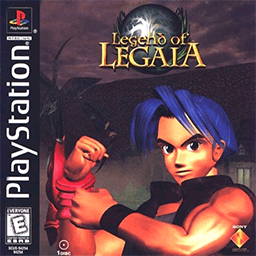Legend of Legaia
| Legend of Legaia | |
|---|---|
 | |
| Developer(s) |
Prokion Contrail (production) |
| Publisher(s) | Sony Computer Entertainment |
| Director(s) | Kazuhiro Kobayashi |
| Producer(s) | Takahiro Kaneko |
| Designer(s) | Natsumi Arisawa |
| Composer(s) | Michiru Ōshima |
| Platform(s) | PlayStation |
| Release | |
| Genre(s) | Adventure, Role-playing |
| Mode(s) | Single-player |
Legend of Legaia (レガイア伝説 Regaia Densetsu) is a PlayStation action role-playing game developed by Prokion and Contrail. It was followed by Legaia 2: Duel Saga.
Gameplay
The player can input any commands for each characters, selects a target and confirms the selection on the battle screen. The action phase has each of them performing their own. The order is prescribed between stats and equipment. The damage is shown for the "Tactical Arts System". Instead of simply selecting a 'Fight' command for a physical attack, the player specifies the location of each ones; 'Right' and 'Left' strike with both arms, and 'High' and 'Low' strike on heights. Each directions has the ability, depending on opponents, equipped weapons and level of the character's skill. Each characters perform a string of attacks. The gauge increases for each turn. The number of strikes is used and affected by several factors for each status. Certain weapons can be used for some characters. Certain strings of attacks initiate combos known as "Arts", which deals more damage than normal attacks. The player can uncover each Arts for every characters. "Arts Points" (AP) uses Arts, draining AP in quantities and is proportionate to the combo length. Inputting Arts sequences without the requisite AP will cause the character to perform string of attacks, without animation and damage bonus. AP can be earned in three ways, dealing physical damage without Arts, taking damage from opponents, or foregoing actions for one turn to reuse Spirit. Arts can be linked by the last and first inputs. The Art ending can linked with another Art, starting with 'Down', allowing the player to use two Arts in a row costing fewer inputs. On the Spirit command, each characters use defensive stances for a turn, increase the chance, regain AP and boost the length of the action bar for the next physical attack. Some boss battles involve enemies after the characters use the Spirit. Each characters can strengthen the power of the Ra-Seru, allowing the human to absorb the powers of Seru defeated in battle. The human can use the absorbed Seru's powers, calling upon it to level up, making it more powerful and causing more effects. All Seru possess an elemental affinity, depending what type of attacks in battle. Ra-Seru possess the affinity, depending the effect they cast any spells.
Plot
Setting
The game takes place in the eponymous world, humans use objects called Seru. They unite and use fantastic powers. While they had once peacefully existed, the mist appears and upsets the Seru, which transforms humans into monsters. Ten years later, human survivors band together to stop the mist, using immune entities called Ra-Seru.
Characters
The main protagonist is Vahn, the village’s martial artist. Noa, a feral child in the city of Conkram, and King Nebular and Queen Minea's daughter. Gala, a warrior monk and the second-in-command teacher. The main antagonist is Prince Cort, the son of Nebular and Minea, and Noa's older brother. He is assisted by Gala's rival Songi and the kingdom's female ruler Zora.
Story
On a quest to destroy all Mist Generators and revive ten Genesis Trees, Vahn, Noa and Gala travel to the past, and learn that Cort used the biological weapon. Back in the present day, they destroy the final generator. After Cort merges with Juggernaut and becomes a gargantuan, the heroes defeat it. With the world restored, the reincarnated Cort becomes a baby.
Reception
| Reception | ||||||
|---|---|---|---|---|---|---|
| ||||||
The game received a score of 77.33% at GameRankings, based on an aggregate of 23 reviews.[1]
References
- 1 2 "Legend of Legaia". GameRankings. Retrieved 2014-09-06.
External links
- Legend of Legaia Shrine at RPG Classics